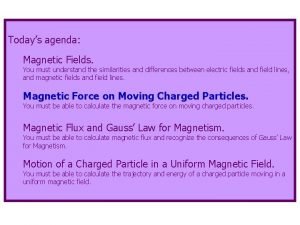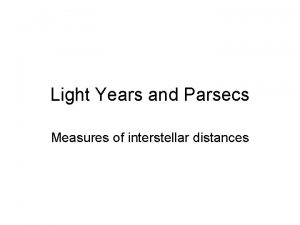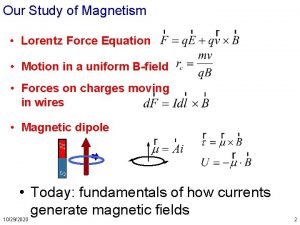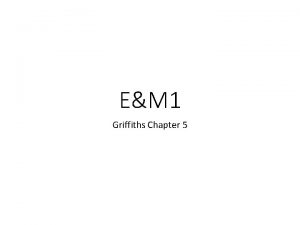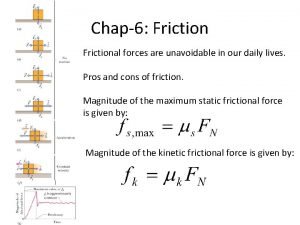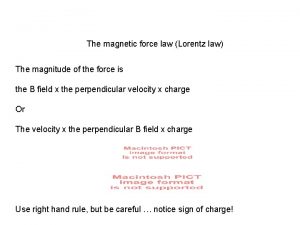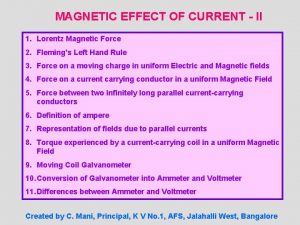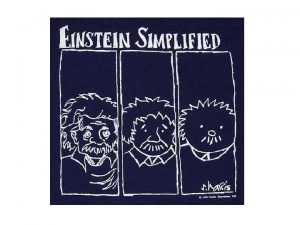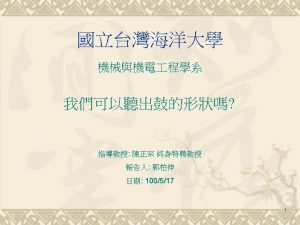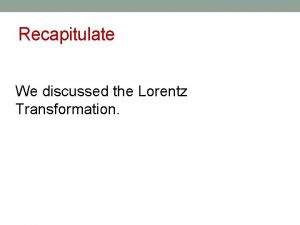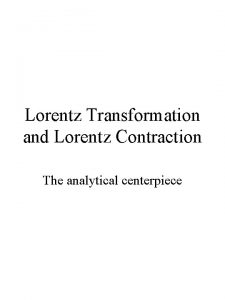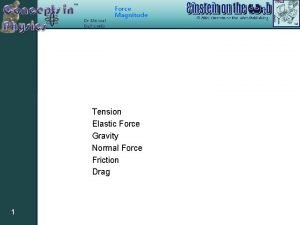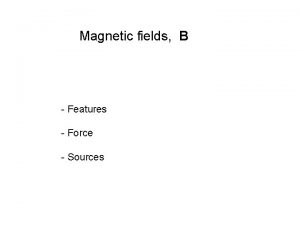Magnetic Force Law the Lorentz Force magnitude Fmagnetic











- Slides: 11

Magnetic Force Law: the Lorentz Force magnitude: Fmagnetic = q v B sin(qv. B) F = qv B direction: right hand rule: thumb = hand fingers Point your right hand in the direction of v, curl you fingers in the direction of B, and the force will be in the direction of your thumb; if the charge is negative, the force direction is opposite that of your thumb or use your left hand. This is the vector cross product. We ran into this right hand rule when we talked about torque in PHYS 150: = r F. An equation similar to the gravitational and electrical force, F=Xpp/r 2 wasn’t useful since we can not separate poles like we could separate charges.

Magnetic Field The Lorentz Force effectively defines the Magnetic Field, B, just like F = q. E and F = mg defined the electric, E, and gravitational, g, fields. The MKS units of B are: Tesla = Nt / [Coul-m/s] = Nt-sec / Coul-m. Since a Tesla is a very large field, this is a common unit for Magnetic Field: 10, 000 Gauss = 1 Tesla.

Forces, Fields and Currents If moving charges are acted upon by magnetic fields (as we just saw), then currents, which consist of moving charges, should be acted upon by fields. Another way of saying the same thing is: fields act on moving charges [F = qv. B sin(qv. B)], and currents consist of moving charges [qv = IDL] , so we have: Fon current = I L B sin(q. IB) with direction: thumb(force) = hand(current) fingers(field).

Torque on a rectangular current loop Recall that torque is: t = r F sin(qr. F) = r F. In the figure below we can see that r = ½w. Thus the Fleft gives a torque of ½w. ILB, and the Fright also gives a torque of ½w. ILB. t N F I r B pole F I S pole w L

Torque on a loop The final result for this loop is: torque = t = N A I B sin(q. IB) sin(qr. F). In this orientation, q. IB = 90 o and qr. F = 90 o. As the loop rotates, we see that q. IB remains at 90 o (the current still goes up and down, the field still goes to the right); but qr. F changes since the direction of the force is constant but the direction of the radius changes as the loop rotates! t = N A I B sin(qr. F).

Electric Motor + N - S The two green “C’s” are actually one ring that is split. The ring is in and out of the screen. The dots “ ” touching the C’s are brushes that brush the inside of the metal C’s as the loop rotates.

Average Torque and Average Power taverage = (2/p) N A I B since the average of |sin(q)| is (2/π) Pavg = avg w = w (2/p) N A I B, and with w = 2 pf, we have: Pavg = 4 f N A I B.

Magnetic Fields Moving charges do create magnetic fields: B = (mo/4 p) q v sin(qvr) / r 2 direction: right hand rule thumb = hand fingers This law is called the Biot-Savart Law Point your right hand in the direction of v, curl you fingers in the direction of r where r is the distance from the moving charge that creates the field to the location in space where the field is, and the field, B, will be in the direction of your thumb; if the charge is negative, the field direction is opposite that of your thumb or use your left hand. The constant (mo/4 p) is a seemingly strange way of writing a constant that serves the same purpose as G and k, but that is exactly what it does. The value: (mo/4 p) = 1 x 10 -7 T*m*sec/Coul (or 1 x 10 -7 T*m/Amp).

Currents and Magnetic Fields B = (mo/4 p) I DL sin(q. Ir) / r 2 with direction: thumb(field) = hand(current) fingers(radius). Bat center of circle = mo. NI / 2 R. Bon axis of circle = mo I R 2 / 2 r 3 Bshort wire = (mo I /4 pa)*[cos(q. L) - cos(q. R)] Blong wire = (mo I /2 pa). Binside-long solenoid = mo n I where n = N/L Binside-short solenoid = ½mo n I [cos(q. R) - cos(q. L)].

Force Between Currents an example I 1 = 0. 5 Amps I 2 = 15 Amps B 1 Ftop 8 cm Fbottom 4 cm 7 cm B 1 is the field due to I 1. By symmetry, the force on the top and bottom parts cancel. Since the left side is closer than the right, the force on the left side will “win”.

Review Basic Magnetic Force Law (Lorentz Force): F = q v B sin(qv. B) or F = qv B Creating Magnetic Fields (Biot-Savart Law): B = (mo/4 p) q v sin(qvr) / r 2 or B = (mo/4 p) q v r/r 3 Gauss’ Law for Magnetism: closed area B d. A = 0 Ampere’s Law: closed loop B d. L = mo Iencircled The dot product ( ) of two vectors is a scalar that involves the magnitudes of the two vectors times the cosine of the angle between them. The cross product ( ) of two vectors is a vector that involves the magnitudes of the two vectors times the sine of the angle between them, and the direction of the resulting vector is perpendicular to both of the other vectors and directed using the right hand rule.
 21lwuy8i6hw -site:youtube.com
21lwuy8i6hw -site:youtube.com Magnitude of magnetic force
Magnitude of magnetic force Magnetic field and magnetic force
Magnetic field and magnetic force What is a parsec?
What is a parsec? Lorentz law
Lorentz law Ampere's law solenoid
Ampere's law solenoid Equation for electromagnetic force
Equation for electromagnetic force Difference between magnetic flux and magnetic flux density
Difference between magnetic flux and magnetic flux density Magnetic field strength h
Magnetic field strength h Magnetic moment and magnetic field relation
Magnetic moment and magnetic field relation Coulombs law
Coulombs law How to determine magnitude of friction force
How to determine magnitude of friction force
